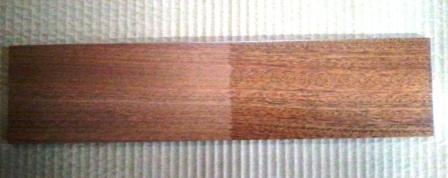I discuss high-tech wood coatings. But from time to time, I will discuss something that is tried and true and, perhaps, not so high tech. Shellac is definitely a low-tech product. It is the secretion of the female Lac bug found in India and Thailand. It takes approximately 100,000 bugs to create 500 grams of shellac flakes.
 There must be a lot of these little ladies doing their thing because shellac is still a widely used product. It functions as a primer, tannin sealer, odor sealer, insulator, and a clear wood finish. Though not terribly robust as a clear finish, none the less, it is not dissolved by anything other than ethyl alcohol.
There must be a lot of these little ladies doing their thing because shellac is still a widely used product. It functions as a primer, tannin sealer, odor sealer, insulator, and a clear wood finish. Though not terribly robust as a clear finish, none the less, it is not dissolved by anything other than ethyl alcohol.
Liquid shellac has a shelf life. That’s why it is so often sold in dry flakes. Liquid versions only lasts about a year. Thereafter, it remains tacky. Also, look for the 100% de-waxed version.
Now, let’s change gears for a moment and talk about water-borne clear finishes.
The facts of life about water-borne
technology include some things that are different from solvent-borne clear coatings. Finishers are well aware that water-bornes “wet the wood” differently.
The “look” is not the same and, in some cases, inferior to what a solvent lacquer will give.
Also, some water-bornes have a bluish-white appearance even when totally cured.
Thirdly, tannins are an issue with water-borne technology since they are miscible in water and tend to migrate up through the coating…even after drying. Usually this is not an issue with a clear, but it certainly can be with a pigmented coating. Tannins can show up days later.
I had the opportunity to do an experiment with some sapele. A customer wanted help with a door he was submitting for approval, and I agreed to spray it for him. I wanted to check out what shellac would do to enhance wetted color so I grabbed a piece of sapele and sprayed a coat on half the sample.
I was really surprised at what the shellac did to the color of the wood. It was as though I had stained the board. The richness was significantly increased.
But when my client brought in his door to be sprayed, his was of highly ribboned sapele. Much lighter in color than my sample, his did not change as dramatically. Therefore, this effect may be selective and will require you to experiment. It may be that shellac adds something to darker woods only.
The board in the picture shown has three coats of pre-cat clear over the shellac. The total dry mils of pre-cat is approximately five.
Changing gears again: M.L. Campbell makes a tannin-blocking primer for use under its pigmented coatings. It sands like a dream. Its secret sauce is a high-tech resin that bonds with the tannins and holds onto them. It is not a shellac-based primer.
My grandpa always said that you could definitely trust a guy who wore both a belt and suspenders. He’d never let you down, he used to say: If you are making a paint-grade project out of a wood with a known reputation for tannin bleed, I’d heed his advice and spray one coat of shellac, scuff, then use the MLC primer. Then, you’re as sure as you can be not to lose your pants on that job.
Tannin bleed often doesn’t show up for several days; by then, some of us will have the project installed. This is a call-back that you definitely don’t want to have! The fix for tannin bleed is NOT fun!






Have something to say? Share your thoughts with us in the comments below.